Business Law Assignment: Company Law and Negligence
VerifiedAdded on 2023/06/05
|10
|2449
|277
Homework Assignment
AI Summary
This business law assignment analyzes three key legal issues through case studies. The first issue examines the concept of the 'veil of incorporation' and its implications for Bob's daughter's advice to form a company to avoid legal obligations. The second issue addresses the liability of a parent company, New Nirvana Ltd, for the negligence of its subsidiary, Nuclear Blast Sounds Pty Ltd, focusing on the duty of care. The final issue explores the legal position of Millennium Pty Ltd when Michael and Simon remove Don from his position as solicitor, and Don initiates legal proceedings. The assignment references relevant cases and legislation, including Salomon v Salomon & Co, Adams v Cape Industries plc, and the Corporations Act, to provide a comprehensive analysis of the legal principles involved and determine the outcomes of each situation.
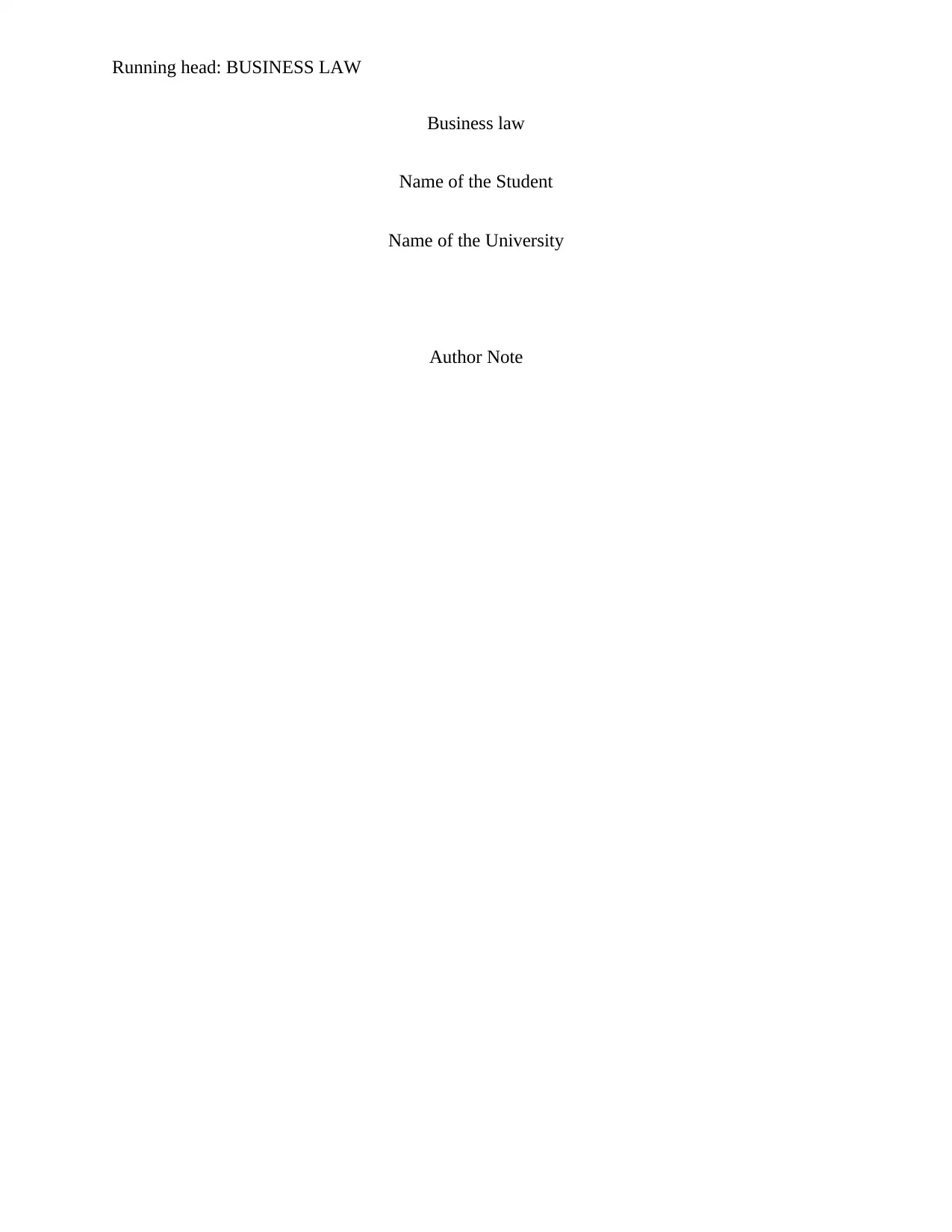
Running head: BUSINESS LAW
Business law
Name of the Student
Name of the University
Author Note
Business law
Name of the Student
Name of the University
Author Note
Paraphrase This Document
Need a fresh take? Get an instant paraphrase of this document with our AI Paraphraser
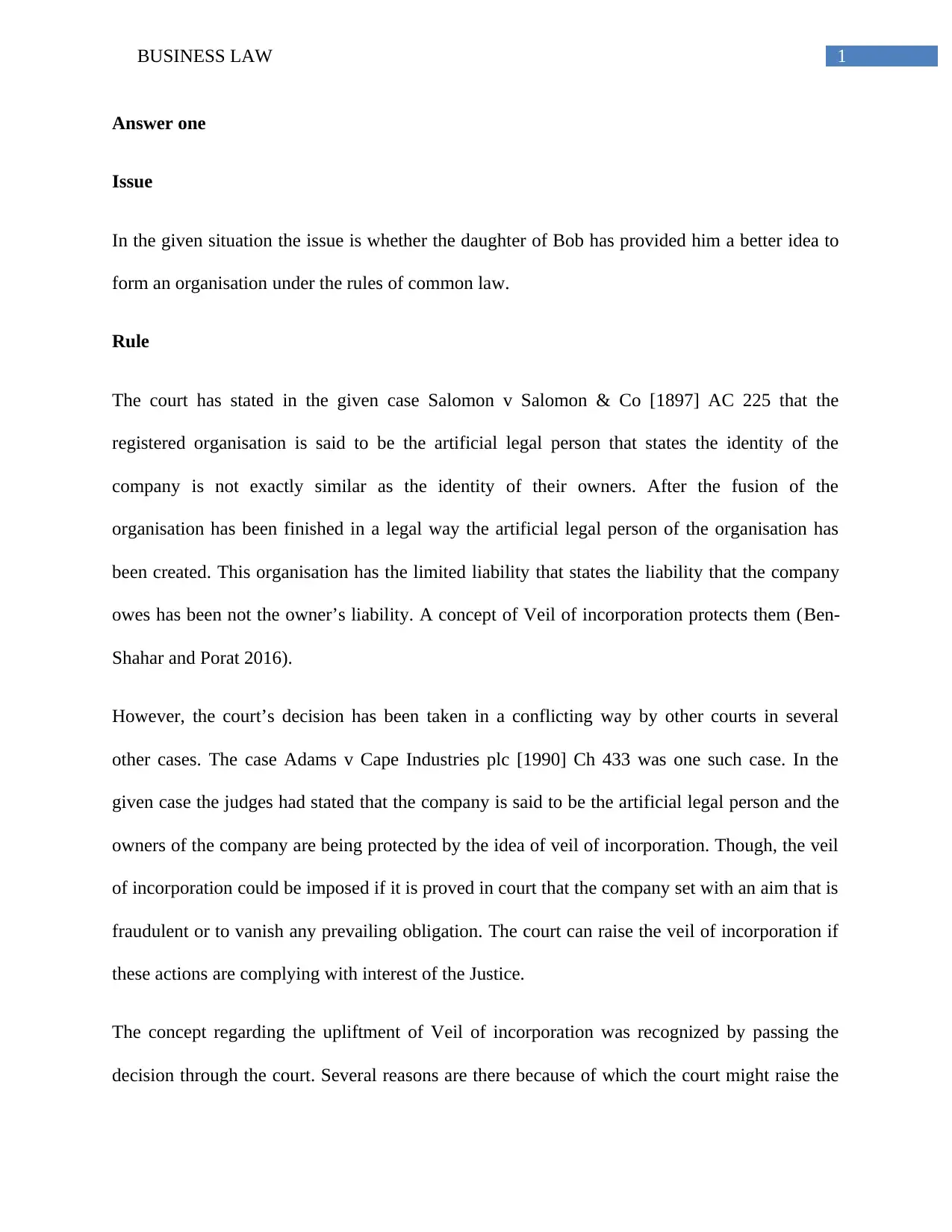
1BUSINESS LAW
Answer one
Issue
In the given situation the issue is whether the daughter of Bob has provided him a better idea to
form an organisation under the rules of common law.
Rule
The court has stated in the given case Salomon v Salomon & Co [1897] AC 225 that the
registered organisation is said to be the artificial legal person that states the identity of the
company is not exactly similar as the identity of their owners. After the fusion of the
organisation has been finished in a legal way the artificial legal person of the organisation has
been created. This organisation has the limited liability that states the liability that the company
owes has been not the owner’s liability. A concept of Veil of incorporation protects them (Ben-
Shahar and Porat 2016).
However, the court’s decision has been taken in a conflicting way by other courts in several
other cases. The case Adams v Cape Industries plc [1990] Ch 433 was one such case. In the
given case the judges had stated that the company is said to be the artificial legal person and the
owners of the company are being protected by the idea of veil of incorporation. Though, the veil
of incorporation could be imposed if it is proved in court that the company set with an aim that is
fraudulent or to vanish any prevailing obligation. The court can raise the veil of incorporation if
these actions are complying with interest of the Justice.
The concept regarding the upliftment of Veil of incorporation was recognized by passing the
decision through the court. Several reasons are there because of which the court might raise the
Answer one
Issue
In the given situation the issue is whether the daughter of Bob has provided him a better idea to
form an organisation under the rules of common law.
Rule
The court has stated in the given case Salomon v Salomon & Co [1897] AC 225 that the
registered organisation is said to be the artificial legal person that states the identity of the
company is not exactly similar as the identity of their owners. After the fusion of the
organisation has been finished in a legal way the artificial legal person of the organisation has
been created. This organisation has the limited liability that states the liability that the company
owes has been not the owner’s liability. A concept of Veil of incorporation protects them (Ben-
Shahar and Porat 2016).
However, the court’s decision has been taken in a conflicting way by other courts in several
other cases. The case Adams v Cape Industries plc [1990] Ch 433 was one such case. In the
given case the judges had stated that the company is said to be the artificial legal person and the
owners of the company are being protected by the idea of veil of incorporation. Though, the veil
of incorporation could be imposed if it is proved in court that the company set with an aim that is
fraudulent or to vanish any prevailing obligation. The court can raise the veil of incorporation if
these actions are complying with interest of the Justice.
The concept regarding the upliftment of Veil of incorporation was recognized by passing the
decision through the court. Several reasons are there because of which the court might raise the
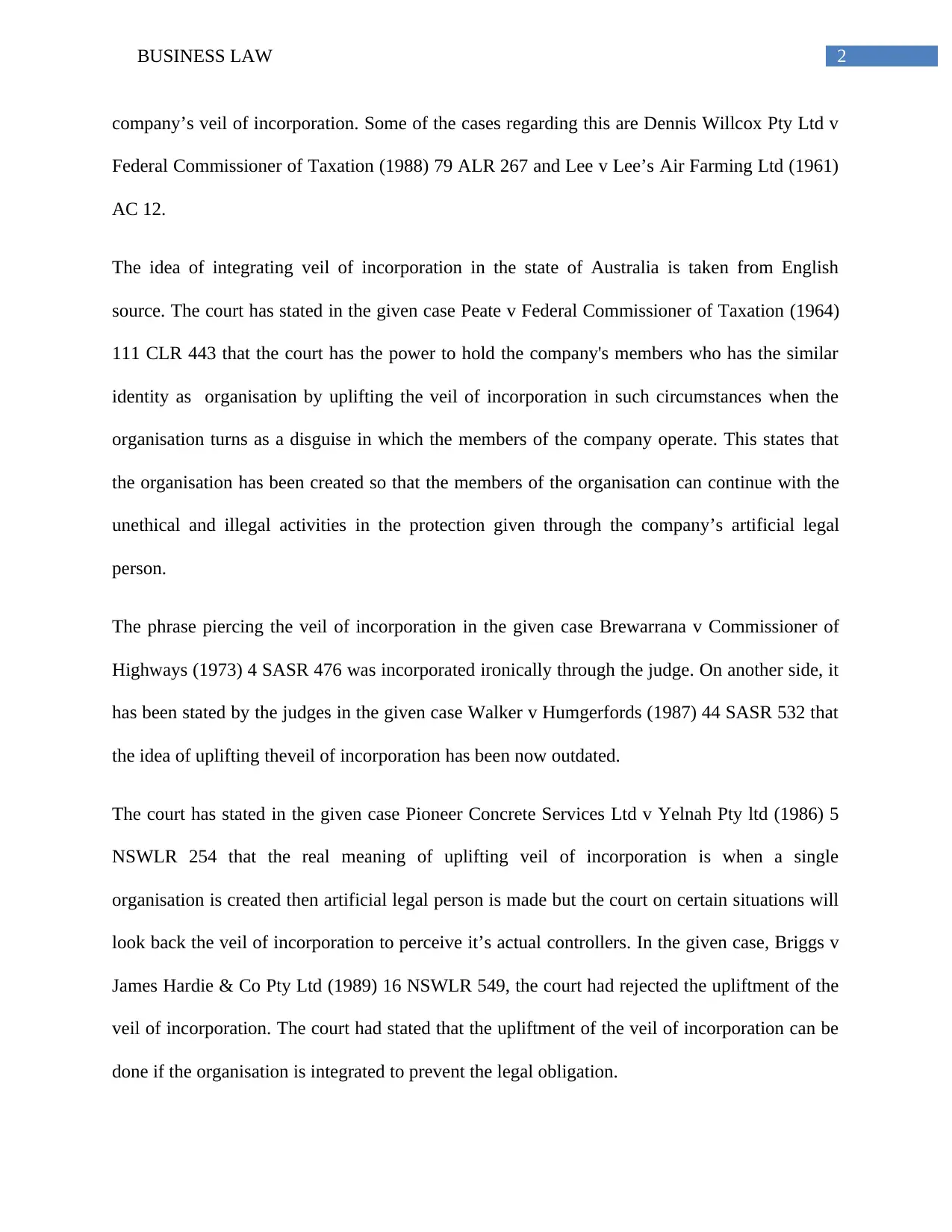
2BUSINESS LAW
company’s veil of incorporation. Some of the cases regarding this are Dennis Willcox Pty Ltd v
Federal Commissioner of Taxation (1988) 79 ALR 267 and Lee v Lee’s Air Farming Ltd (1961)
AC 12.
The idea of integrating veil of incorporation in the state of Australia is taken from English
source. The court has stated in the given case Peate v Federal Commissioner of Taxation (1964)
111 CLR 443 that the court has the power to hold the company's members who has the similar
identity as organisation by uplifting the veil of incorporation in such circumstances when the
organisation turns as a disguise in which the members of the company operate. This states that
the organisation has been created so that the members of the organisation can continue with the
unethical and illegal activities in the protection given through the company’s artificial legal
person.
The phrase piercing the veil of incorporation in the given case Brewarrana v Commissioner of
Highways (1973) 4 SASR 476 was incorporated ironically through the judge. On another side, it
has been stated by the judges in the given case Walker v Humgerfords (1987) 44 SASR 532 that
the idea of uplifting theveil of incorporation has been now outdated.
The court has stated in the given case Pioneer Concrete Services Ltd v Yelnah Pty ltd (1986) 5
NSWLR 254 that the real meaning of uplifting veil of incorporation is when a single
organisation is created then artificial legal person is made but the court on certain situations will
look back the veil of incorporation to perceive it’s actual controllers. In the given case, Briggs v
James Hardie & Co Pty Ltd (1989) 16 NSWLR 549, the court had rejected the upliftment of the
veil of incorporation. The court had stated that the upliftment of the veil of incorporation can be
done if the organisation is integrated to prevent the legal obligation.
company’s veil of incorporation. Some of the cases regarding this are Dennis Willcox Pty Ltd v
Federal Commissioner of Taxation (1988) 79 ALR 267 and Lee v Lee’s Air Farming Ltd (1961)
AC 12.
The idea of integrating veil of incorporation in the state of Australia is taken from English
source. The court has stated in the given case Peate v Federal Commissioner of Taxation (1964)
111 CLR 443 that the court has the power to hold the company's members who has the similar
identity as organisation by uplifting the veil of incorporation in such circumstances when the
organisation turns as a disguise in which the members of the company operate. This states that
the organisation has been created so that the members of the organisation can continue with the
unethical and illegal activities in the protection given through the company’s artificial legal
person.
The phrase piercing the veil of incorporation in the given case Brewarrana v Commissioner of
Highways (1973) 4 SASR 476 was incorporated ironically through the judge. On another side, it
has been stated by the judges in the given case Walker v Humgerfords (1987) 44 SASR 532 that
the idea of uplifting theveil of incorporation has been now outdated.
The court has stated in the given case Pioneer Concrete Services Ltd v Yelnah Pty ltd (1986) 5
NSWLR 254 that the real meaning of uplifting veil of incorporation is when a single
organisation is created then artificial legal person is made but the court on certain situations will
look back the veil of incorporation to perceive it’s actual controllers. In the given case, Briggs v
James Hardie & Co Pty Ltd (1989) 16 NSWLR 549, the court had rejected the upliftment of the
veil of incorporation. The court had stated that the upliftment of the veil of incorporation can be
done if the organisation is integrated to prevent the legal obligation.
⊘ This is a preview!⊘
Do you want full access?
Subscribe today to unlock all pages.

Trusted by 1+ million students worldwide
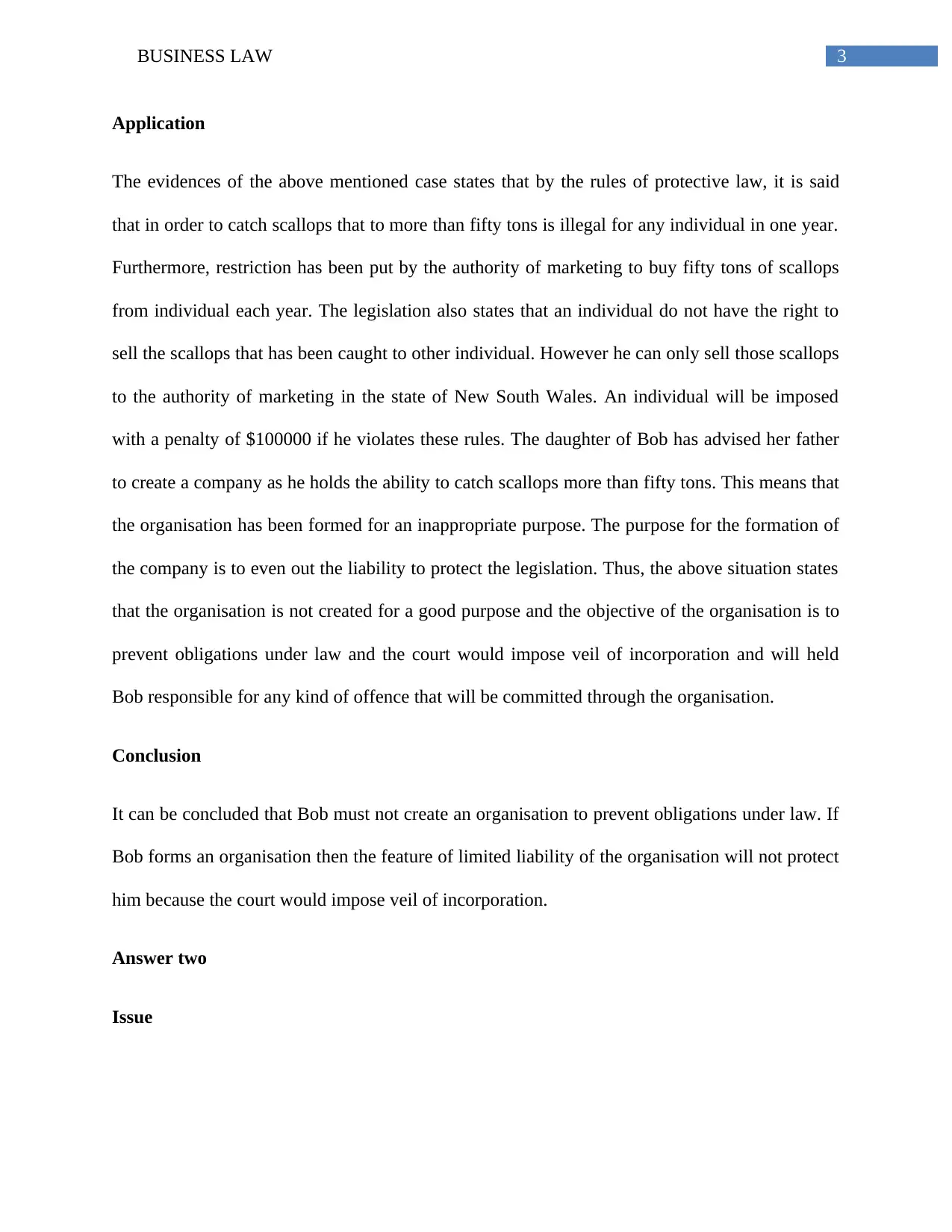
3BUSINESS LAW
Application
The evidences of the above mentioned case states that by the rules of protective law, it is said
that in order to catch scallops that to more than fifty tons is illegal for any individual in one year.
Furthermore, restriction has been put by the authority of marketing to buy fifty tons of scallops
from individual each year. The legislation also states that an individual do not have the right to
sell the scallops that has been caught to other individual. However he can only sell those scallops
to the authority of marketing in the state of New South Wales. An individual will be imposed
with a penalty of $100000 if he violates these rules. The daughter of Bob has advised her father
to create a company as he holds the ability to catch scallops more than fifty tons. This means that
the organisation has been formed for an inappropriate purpose. The purpose for the formation of
the company is to even out the liability to protect the legislation. Thus, the above situation states
that the organisation is not created for a good purpose and the objective of the organisation is to
prevent obligations under law and the court would impose veil of incorporation and will held
Bob responsible for any kind of offence that will be committed through the organisation.
Conclusion
It can be concluded that Bob must not create an organisation to prevent obligations under law. If
Bob forms an organisation then the feature of limited liability of the organisation will not protect
him because the court would impose veil of incorporation.
Answer two
Issue
Application
The evidences of the above mentioned case states that by the rules of protective law, it is said
that in order to catch scallops that to more than fifty tons is illegal for any individual in one year.
Furthermore, restriction has been put by the authority of marketing to buy fifty tons of scallops
from individual each year. The legislation also states that an individual do not have the right to
sell the scallops that has been caught to other individual. However he can only sell those scallops
to the authority of marketing in the state of New South Wales. An individual will be imposed
with a penalty of $100000 if he violates these rules. The daughter of Bob has advised her father
to create a company as he holds the ability to catch scallops more than fifty tons. This means that
the organisation has been formed for an inappropriate purpose. The purpose for the formation of
the company is to even out the liability to protect the legislation. Thus, the above situation states
that the organisation is not created for a good purpose and the objective of the organisation is to
prevent obligations under law and the court would impose veil of incorporation and will held
Bob responsible for any kind of offence that will be committed through the organisation.
Conclusion
It can be concluded that Bob must not create an organisation to prevent obligations under law. If
Bob forms an organisation then the feature of limited liability of the organisation will not protect
him because the court would impose veil of incorporation.
Answer two
Issue
Paraphrase This Document
Need a fresh take? Get an instant paraphrase of this document with our AI Paraphraser
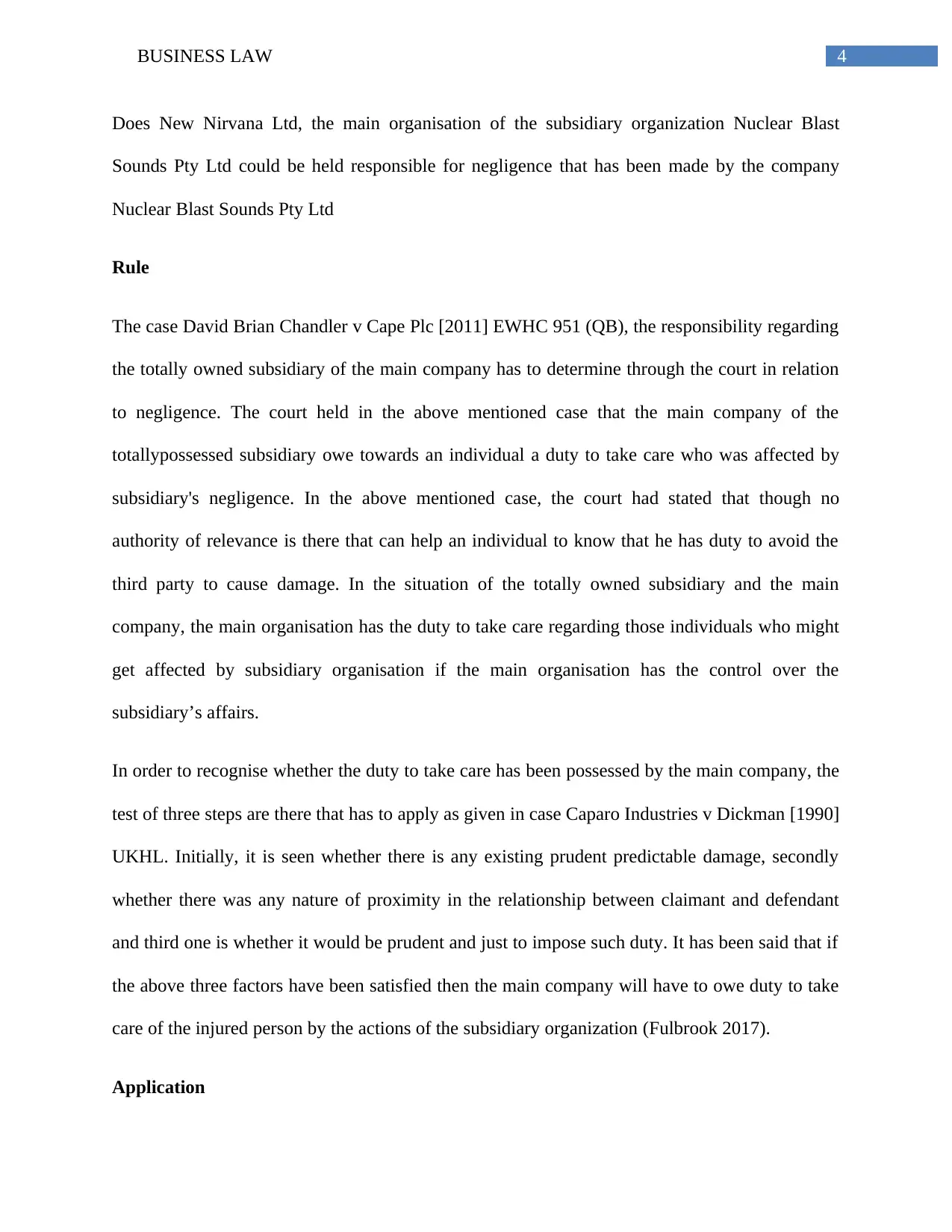
4BUSINESS LAW
Does New Nirvana Ltd, the main organisation of the subsidiary organization Nuclear Blast
Sounds Pty Ltd could be held responsible for negligence that has been made by the company
Nuclear Blast Sounds Pty Ltd
Rule
The case David Brian Chandler v Cape Plc [2011] EWHC 951 (QB), the responsibility regarding
the totally owned subsidiary of the main company has to determine through the court in relation
to negligence. The court held in the above mentioned case that the main company of the
totallypossessed subsidiary owe towards an individual a duty to take care who was affected by
subsidiary's negligence. In the above mentioned case, the court had stated that though no
authority of relevance is there that can help an individual to know that he has duty to avoid the
third party to cause damage. In the situation of the totally owned subsidiary and the main
company, the main organisation has the duty to take care regarding those individuals who might
get affected by subsidiary organisation if the main organisation has the control over the
subsidiary’s affairs.
In order to recognise whether the duty to take care has been possessed by the main company, the
test of three steps are there that has to apply as given in case Caparo Industries v Dickman [1990]
UKHL. Initially, it is seen whether there is any existing prudent predictable damage, secondly
whether there was any nature of proximity in the relationship between claimant and defendant
and third one is whether it would be prudent and just to impose such duty. It has been said that if
the above three factors have been satisfied then the main company will have to owe duty to take
care of the injured person by the actions of the subsidiary organization (Fulbrook 2017).
Application
Does New Nirvana Ltd, the main organisation of the subsidiary organization Nuclear Blast
Sounds Pty Ltd could be held responsible for negligence that has been made by the company
Nuclear Blast Sounds Pty Ltd
Rule
The case David Brian Chandler v Cape Plc [2011] EWHC 951 (QB), the responsibility regarding
the totally owned subsidiary of the main company has to determine through the court in relation
to negligence. The court held in the above mentioned case that the main company of the
totallypossessed subsidiary owe towards an individual a duty to take care who was affected by
subsidiary's negligence. In the above mentioned case, the court had stated that though no
authority of relevance is there that can help an individual to know that he has duty to avoid the
third party to cause damage. In the situation of the totally owned subsidiary and the main
company, the main organisation has the duty to take care regarding those individuals who might
get affected by subsidiary organisation if the main organisation has the control over the
subsidiary’s affairs.
In order to recognise whether the duty to take care has been possessed by the main company, the
test of three steps are there that has to apply as given in case Caparo Industries v Dickman [1990]
UKHL. Initially, it is seen whether there is any existing prudent predictable damage, secondly
whether there was any nature of proximity in the relationship between claimant and defendant
and third one is whether it would be prudent and just to impose such duty. It has been said that if
the above three factors have been satisfied then the main company will have to owe duty to take
care of the injured person by the actions of the subsidiary organization (Fulbrook 2017).
Application
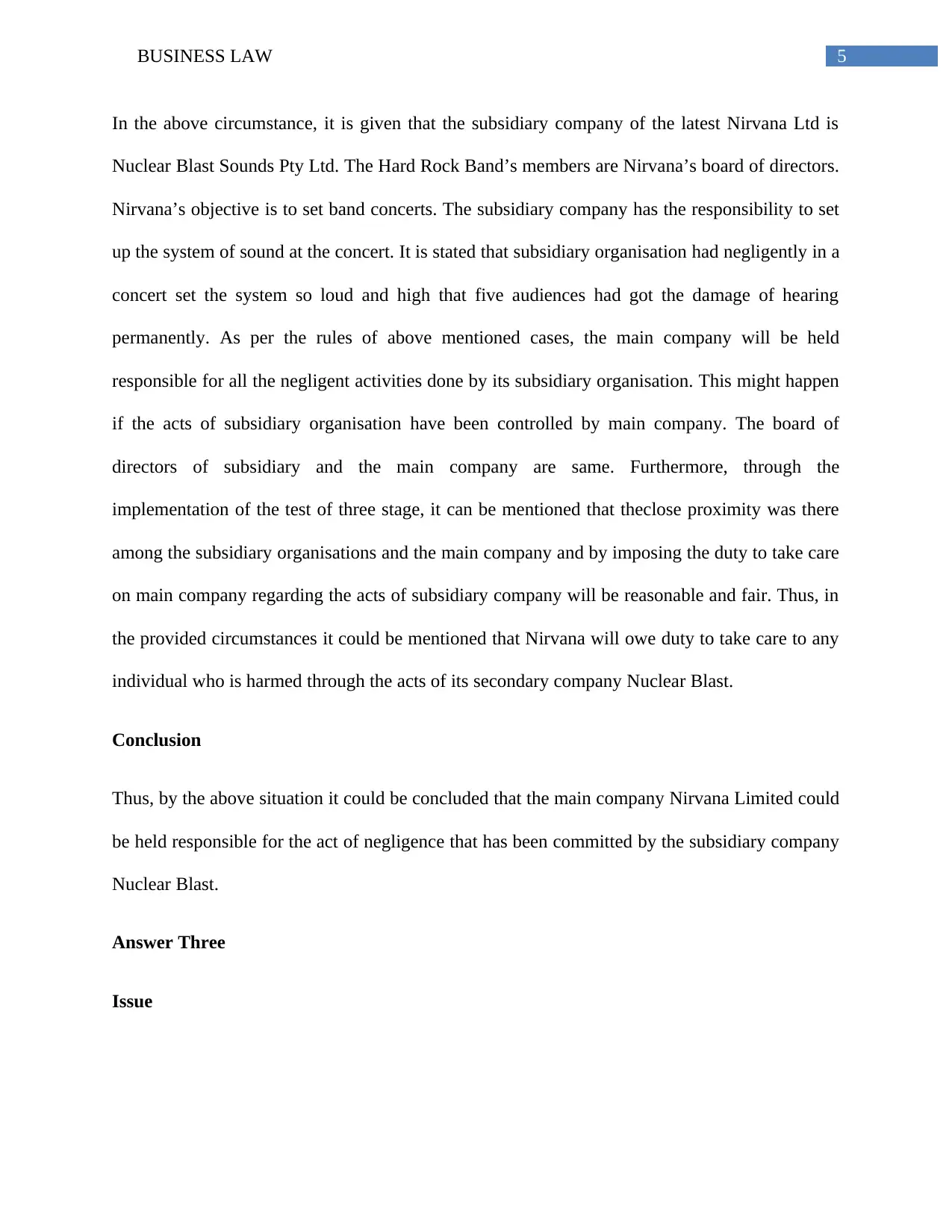
5BUSINESS LAW
In the above circumstance, it is given that the subsidiary company of the latest Nirvana Ltd is
Nuclear Blast Sounds Pty Ltd. The Hard Rock Band’s members are Nirvana’s board of directors.
Nirvana’s objective is to set band concerts. The subsidiary company has the responsibility to set
up the system of sound at the concert. It is stated that subsidiary organisation had negligently in a
concert set the system so loud and high that five audiences had got the damage of hearing
permanently. As per the rules of above mentioned cases, the main company will be held
responsible for all the negligent activities done by its subsidiary organisation. This might happen
if the acts of subsidiary organisation have been controlled by main company. The board of
directors of subsidiary and the main company are same. Furthermore, through the
implementation of the test of three stage, it can be mentioned that theclose proximity was there
among the subsidiary organisations and the main company and by imposing the duty to take care
on main company regarding the acts of subsidiary company will be reasonable and fair. Thus, in
the provided circumstances it could be mentioned that Nirvana will owe duty to take care to any
individual who is harmed through the acts of its secondary company Nuclear Blast.
Conclusion
Thus, by the above situation it could be concluded that the main company Nirvana Limited could
be held responsible for the act of negligence that has been committed by the subsidiary company
Nuclear Blast.
Answer Three
Issue
In the above circumstance, it is given that the subsidiary company of the latest Nirvana Ltd is
Nuclear Blast Sounds Pty Ltd. The Hard Rock Band’s members are Nirvana’s board of directors.
Nirvana’s objective is to set band concerts. The subsidiary company has the responsibility to set
up the system of sound at the concert. It is stated that subsidiary organisation had negligently in a
concert set the system so loud and high that five audiences had got the damage of hearing
permanently. As per the rules of above mentioned cases, the main company will be held
responsible for all the negligent activities done by its subsidiary organisation. This might happen
if the acts of subsidiary organisation have been controlled by main company. The board of
directors of subsidiary and the main company are same. Furthermore, through the
implementation of the test of three stage, it can be mentioned that theclose proximity was there
among the subsidiary organisations and the main company and by imposing the duty to take care
on main company regarding the acts of subsidiary company will be reasonable and fair. Thus, in
the provided circumstances it could be mentioned that Nirvana will owe duty to take care to any
individual who is harmed through the acts of its secondary company Nuclear Blast.
Conclusion
Thus, by the above situation it could be concluded that the main company Nirvana Limited could
be held responsible for the act of negligence that has been committed by the subsidiary company
Nuclear Blast.
Answer Three
Issue
⊘ This is a preview!⊘
Do you want full access?
Subscribe today to unlock all pages.

Trusted by 1+ million students worldwide
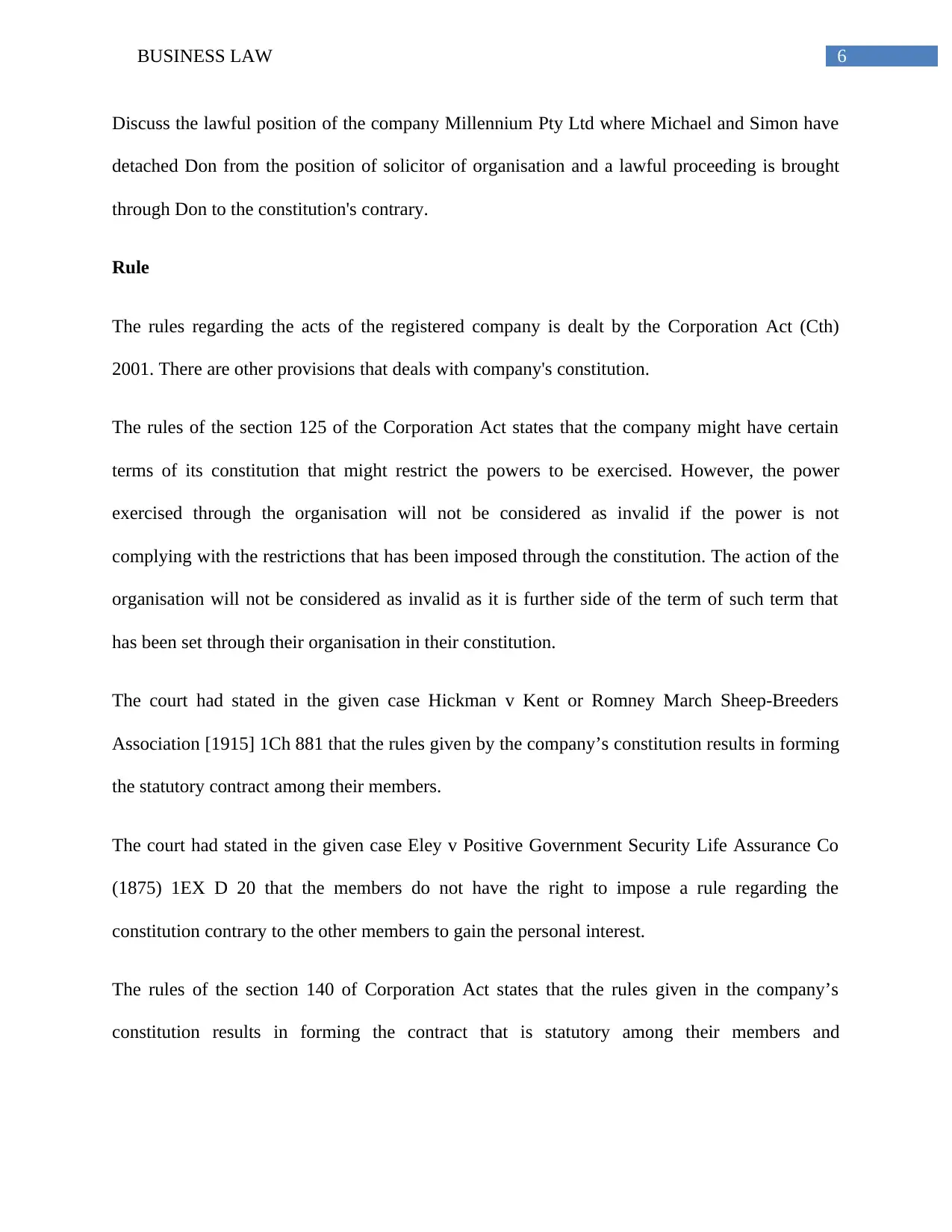
6BUSINESS LAW
Discuss the lawful position of the company Millennium Pty Ltd where Michael and Simon have
detached Don from the position of solicitor of organisation and a lawful proceeding is brought
through Don to the constitution's contrary.
Rule
The rules regarding the acts of the registered company is dealt by the Corporation Act (Cth)
2001. There are other provisions that deals with company's constitution.
The rules of the section 125 of the Corporation Act states that the company might have certain
terms of its constitution that might restrict the powers to be exercised. However, the power
exercised through the organisation will not be considered as invalid if the power is not
complying with the restrictions that has been imposed through the constitution. The action of the
organisation will not be considered as invalid as it is further side of the term of such term that
has been set through their organisation in their constitution.
The court had stated in the given case Hickman v Kent or Romney March Sheep-Breeders
Association [1915] 1Ch 881 that the rules given by the company’s constitution results in forming
the statutory contract among their members.
The court had stated in the given case Eley v Positive Government Security Life Assurance Co
(1875) 1EX D 20 that the members do not have the right to impose a rule regarding the
constitution contrary to the other members to gain the personal interest.
The rules of the section 140 of Corporation Act states that the rules given in the company’s
constitution results in forming the contract that is statutory among their members and
Discuss the lawful position of the company Millennium Pty Ltd where Michael and Simon have
detached Don from the position of solicitor of organisation and a lawful proceeding is brought
through Don to the constitution's contrary.
Rule
The rules regarding the acts of the registered company is dealt by the Corporation Act (Cth)
2001. There are other provisions that deals with company's constitution.
The rules of the section 125 of the Corporation Act states that the company might have certain
terms of its constitution that might restrict the powers to be exercised. However, the power
exercised through the organisation will not be considered as invalid if the power is not
complying with the restrictions that has been imposed through the constitution. The action of the
organisation will not be considered as invalid as it is further side of the term of such term that
has been set through their organisation in their constitution.
The court had stated in the given case Hickman v Kent or Romney March Sheep-Breeders
Association [1915] 1Ch 881 that the rules given by the company’s constitution results in forming
the statutory contract among their members.
The court had stated in the given case Eley v Positive Government Security Life Assurance Co
(1875) 1EX D 20 that the members do not have the right to impose a rule regarding the
constitution contrary to the other members to gain the personal interest.
The rules of the section 140 of Corporation Act states that the rules given in the company’s
constitution results in forming the contract that is statutory among their members and
Paraphrase This Document
Need a fresh take? Get an instant paraphrase of this document with our AI Paraphraser
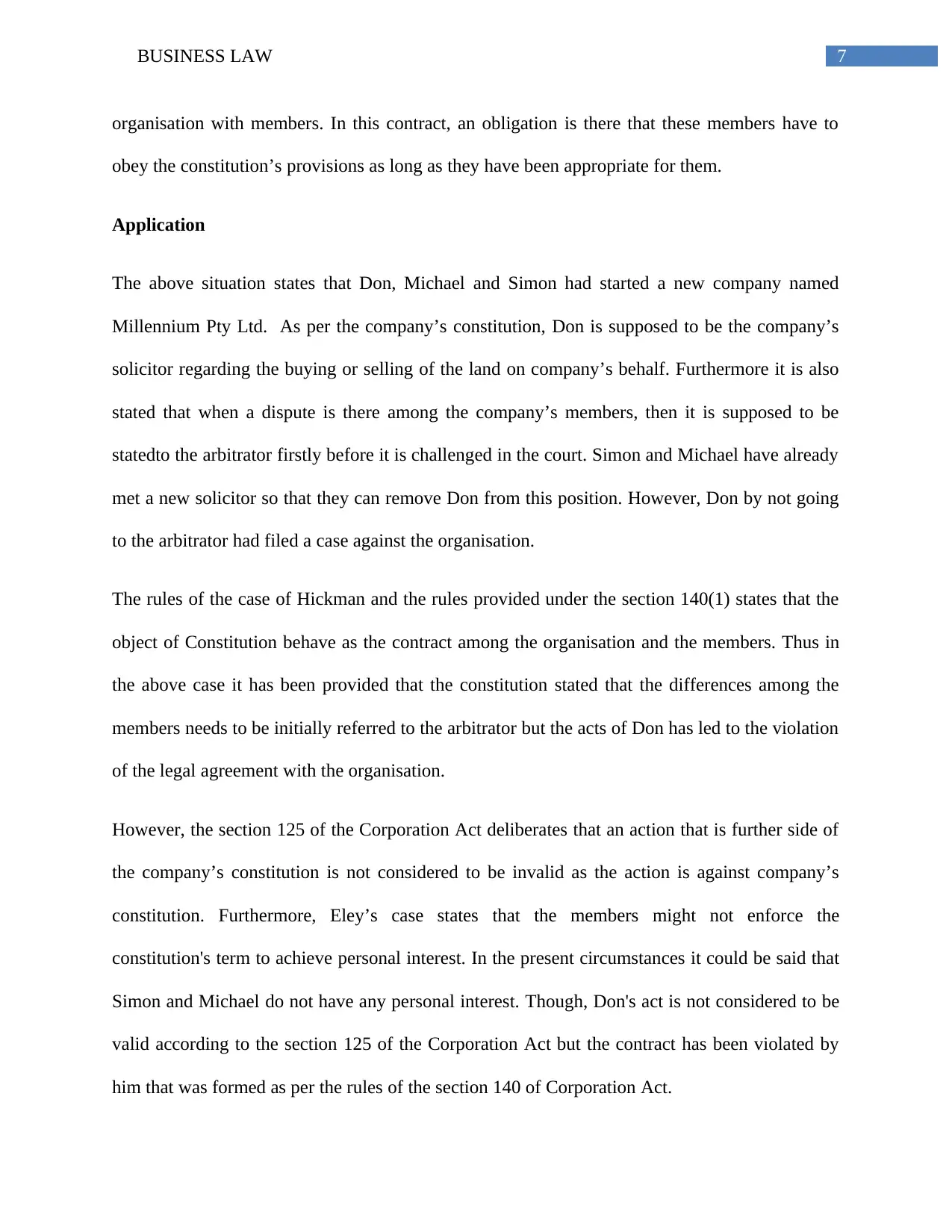
7BUSINESS LAW
organisation with members. In this contract, an obligation is there that these members have to
obey the constitution’s provisions as long as they have been appropriate for them.
Application
The above situation states that Don, Michael and Simon had started a new company named
Millennium Pty Ltd. As per the company’s constitution, Don is supposed to be the company’s
solicitor regarding the buying or selling of the land on company’s behalf. Furthermore it is also
stated that when a dispute is there among the company’s members, then it is supposed to be
statedto the arbitrator firstly before it is challenged in the court. Simon and Michael have already
met a new solicitor so that they can remove Don from this position. However, Don by not going
to the arbitrator had filed a case against the organisation.
The rules of the case of Hickman and the rules provided under the section 140(1) states that the
object of Constitution behave as the contract among the organisation and the members. Thus in
the above case it has been provided that the constitution stated that the differences among the
members needs to be initially referred to the arbitrator but the acts of Don has led to the violation
of the legal agreement with the organisation.
However, the section 125 of the Corporation Act deliberates that an action that is further side of
the company’s constitution is not considered to be invalid as the action is against company’s
constitution. Furthermore, Eley’s case states that the members might not enforce the
constitution's term to achieve personal interest. In the present circumstances it could be said that
Simon and Michael do not have any personal interest. Though, Don's act is not considered to be
valid according to the section 125 of the Corporation Act but the contract has been violated by
him that was formed as per the rules of the section 140 of Corporation Act.
organisation with members. In this contract, an obligation is there that these members have to
obey the constitution’s provisions as long as they have been appropriate for them.
Application
The above situation states that Don, Michael and Simon had started a new company named
Millennium Pty Ltd. As per the company’s constitution, Don is supposed to be the company’s
solicitor regarding the buying or selling of the land on company’s behalf. Furthermore it is also
stated that when a dispute is there among the company’s members, then it is supposed to be
statedto the arbitrator firstly before it is challenged in the court. Simon and Michael have already
met a new solicitor so that they can remove Don from this position. However, Don by not going
to the arbitrator had filed a case against the organisation.
The rules of the case of Hickman and the rules provided under the section 140(1) states that the
object of Constitution behave as the contract among the organisation and the members. Thus in
the above case it has been provided that the constitution stated that the differences among the
members needs to be initially referred to the arbitrator but the acts of Don has led to the violation
of the legal agreement with the organisation.
However, the section 125 of the Corporation Act deliberates that an action that is further side of
the company’s constitution is not considered to be invalid as the action is against company’s
constitution. Furthermore, Eley’s case states that the members might not enforce the
constitution's term to achieve personal interest. In the present circumstances it could be said that
Simon and Michael do not have any personal interest. Though, Don's act is not considered to be
valid according to the section 125 of the Corporation Act but the contract has been violated by
him that was formed as per the rules of the section 140 of Corporation Act.
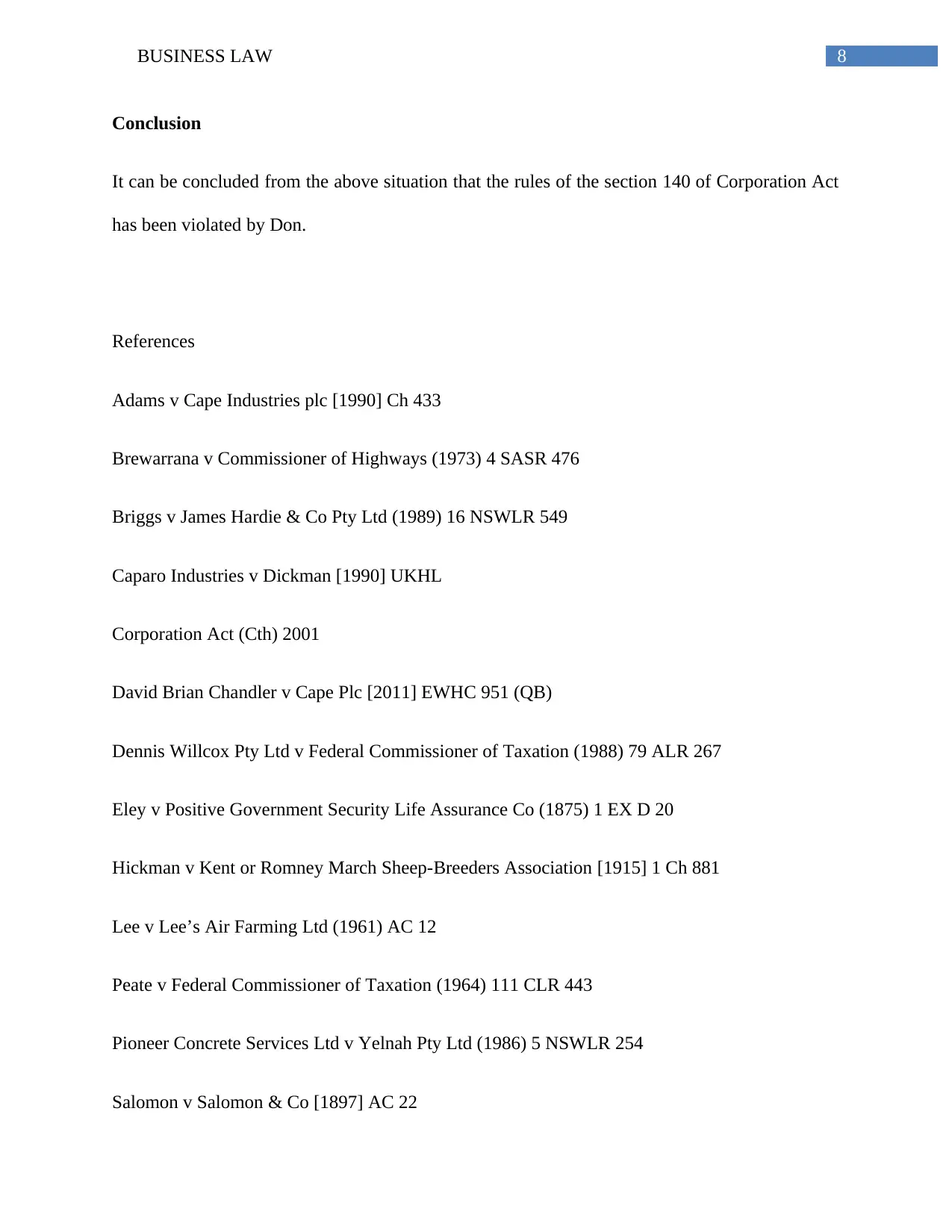
8BUSINESS LAW
Conclusion
It can be concluded from the above situation that the rules of the section 140 of Corporation Act
has been violated by Don.
References
Adams v Cape Industries plc [1990] Ch 433
Brewarrana v Commissioner of Highways (1973) 4 SASR 476
Briggs v James Hardie & Co Pty Ltd (1989) 16 NSWLR 549
Caparo Industries v Dickman [1990] UKHL
Corporation Act (Cth) 2001
David Brian Chandler v Cape Plc [2011] EWHC 951 (QB)
Dennis Willcox Pty Ltd v Federal Commissioner of Taxation (1988) 79 ALR 267
Eley v Positive Government Security Life Assurance Co (1875) 1 EX D 20
Hickman v Kent or Romney March Sheep-Breeders Association [1915] 1 Ch 881
Lee v Lee’s Air Farming Ltd (1961) AC 12
Peate v Federal Commissioner of Taxation (1964) 111 CLR 443
Pioneer Concrete Services Ltd v Yelnah Pty Ltd (1986) 5 NSWLR 254
Salomon v Salomon & Co [1897] AC 22
Conclusion
It can be concluded from the above situation that the rules of the section 140 of Corporation Act
has been violated by Don.
References
Adams v Cape Industries plc [1990] Ch 433
Brewarrana v Commissioner of Highways (1973) 4 SASR 476
Briggs v James Hardie & Co Pty Ltd (1989) 16 NSWLR 549
Caparo Industries v Dickman [1990] UKHL
Corporation Act (Cth) 2001
David Brian Chandler v Cape Plc [2011] EWHC 951 (QB)
Dennis Willcox Pty Ltd v Federal Commissioner of Taxation (1988) 79 ALR 267
Eley v Positive Government Security Life Assurance Co (1875) 1 EX D 20
Hickman v Kent or Romney March Sheep-Breeders Association [1915] 1 Ch 881
Lee v Lee’s Air Farming Ltd (1961) AC 12
Peate v Federal Commissioner of Taxation (1964) 111 CLR 443
Pioneer Concrete Services Ltd v Yelnah Pty Ltd (1986) 5 NSWLR 254
Salomon v Salomon & Co [1897] AC 22
⊘ This is a preview!⊘
Do you want full access?
Subscribe today to unlock all pages.

Trusted by 1+ million students worldwide
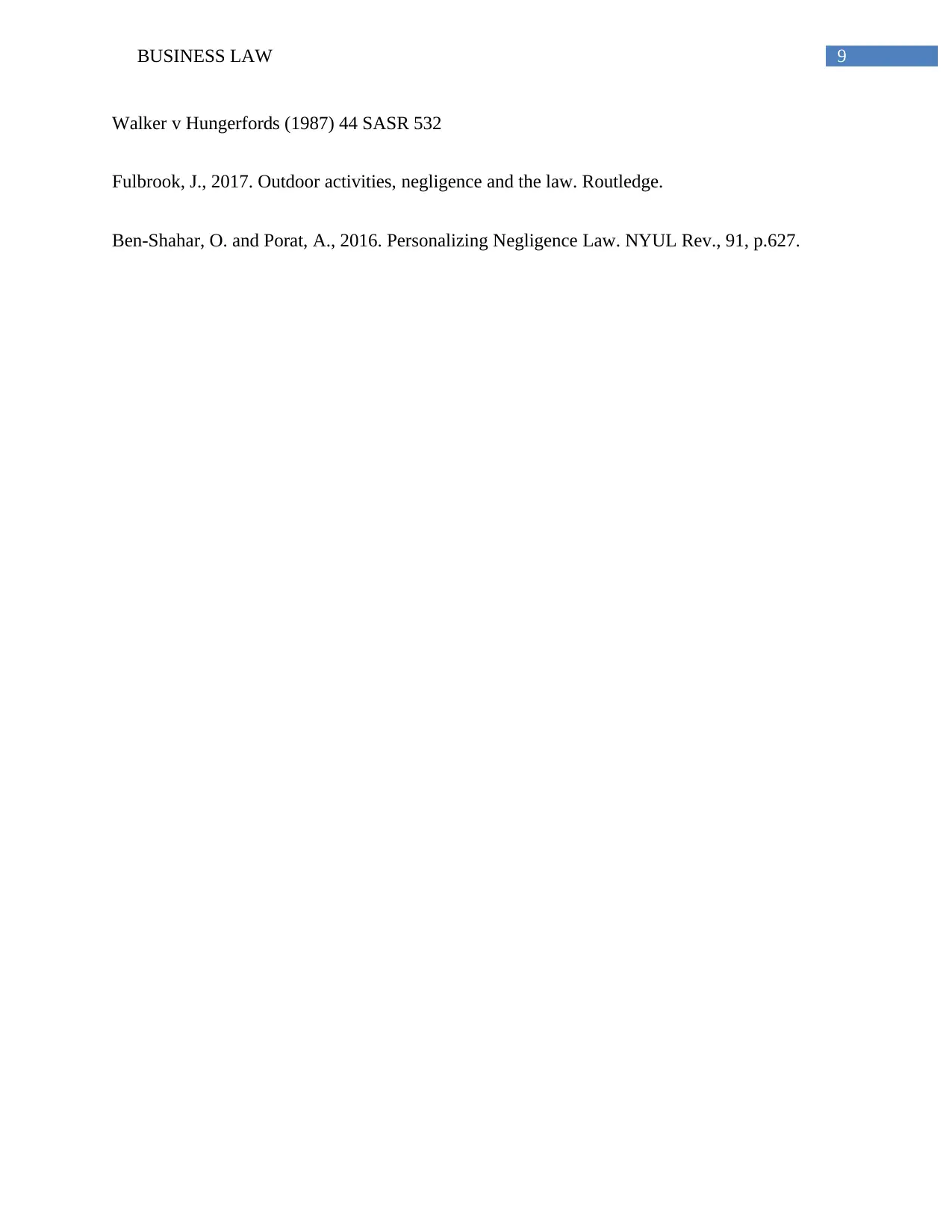
9BUSINESS LAW
Walker v Hungerfords (1987) 44 SASR 532
Fulbrook, J., 2017. Outdoor activities, negligence and the law. Routledge.
Ben-Shahar, O. and Porat, A., 2016. Personalizing Negligence Law. NYUL Rev., 91, p.627.
Walker v Hungerfords (1987) 44 SASR 532
Fulbrook, J., 2017. Outdoor activities, negligence and the law. Routledge.
Ben-Shahar, O. and Porat, A., 2016. Personalizing Negligence Law. NYUL Rev., 91, p.627.
1 out of 10
Related Documents
Your All-in-One AI-Powered Toolkit for Academic Success.
+13062052269
info@desklib.com
Available 24*7 on WhatsApp / Email
![[object Object]](/_next/static/media/star-bottom.7253800d.svg)
Unlock your academic potential
Copyright © 2020–2025 A2Z Services. All Rights Reserved. Developed and managed by ZUCOL.





